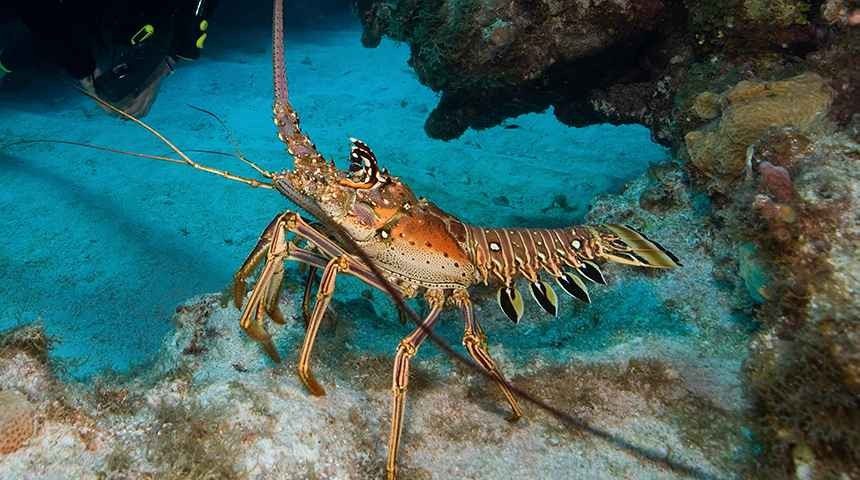The Lobster Considered
Once there was a time when the reefs and shallow shores of the Cayman Islands teemed with lobster.

 Satina Dacosta
Satina Dacosta
Older Caymanians lament a time when this marine crustacean was so prolific it could be pulled from any rock a few steps from the beach. Yet lobster did not have the gastronomic appeal of today, nor was it seen as a valued commodity.
Prior to Cayman’s current awareness of marine conservation, juveniles were regularly used as bait in fishpots. The lowly status of lobster also existed in the minds of others, not just early Caymanians... In his essay Consider the Lobster, the late David Foster Wallace revealed that in the early 1800s, before America gained her independence, certain colonies in the Northeast considered lobster to be such undesirable fare it was fed to prisoners. If familiarity breeds contempt, then so does an oversupply… of anything. Serving prisoners lobster more than once per week was considered a cruel and unusual punishment! Lobster numbers were so remarkable in states such as Maine, that this throwaway meal for society’s outcasts was also used as fertilizer. Considering that it would have been a ready source of protein, it is unlikely that all of Cayman’s early settlers shared this level of disdain; though oral history records, at the Cayman Islands National Archive, suggest a definite indifference. In an archival interview, older Caymanian, Brent Bush, recalled "once in a while [we would] eat 'em, but nobody bothered with the lobster too much." Poles apart were early attitudes towards beef— with livestock being a rare provision for most; beef was a dish Caymanians of the past craved, especially during Christmas time when everyone saved up their shillings to purchase whatever they could afford.
Lobster Transformed
Today beef is no longer a luxury. The large fleshy tail of a locally caught lobster on the other hand, commands a very high market price in certain restaurants. Found along Cayman’s reefs, throughout the Caribbean Sea, Atlantic Ocean and the Gulf of Mexico, this clawless invertebrate— a veritable sea insect— is known as the Caribbean spiny lobster. Smaller than its US cousin that dwells in the chilly waters off the Northeast coast, the lobster’s reputation has undergone a global transformation. Considered an upmarket choice, lobster is good eating. Counter to the widely accepted view that it should be shunned by the health-conscious; lobster actually has fewer calories, cholesterol and saturated fat than chicken. Compared to other seafood choices such as crab, lobster's rich, yet more subtle flavour lends itself to culinary versatility. It is a common scene to find the modern day lobster lover wolfing down a whole tail, with steak and potatoes on the side. For the minimalist, the sharp lemony astringency of lobster ceviche is the only way to go! On the other hand, the decadent diner may desire more flare, so Lobster Thermidor would fit the bill perfectly. This rich French dish is a creamy mixture of cooked lobster meat, egg yolks and brandy, which is then stuffed into a lobster shell, topped with Gruyère cheese and finished in the oven to achieve a browned crisp top. But the purist would scoff at any such manipulation, maintaining that the only way to eat fresh lobster is boiled or steamed with a healthy serving of melted butter.
Yet eating a whole lobster tail would have been a strange and possibly an unsavoury affair for early Caymanians. Furthermore, that generous helping of butter favoured by the purist, would have been impossible for most people to source, and for those who could, it may have been deemed a bit wasteful considering butter was a highly regarded commodity. Only people with 'disposable' income— well shillings— or farmers with milk-producing cattle could afford it.
Less Is More
The traditional preparation of lobster was simple (and still is): boiled in the shell until tender, diced into bite size pieces, and sautéed in oil with a few peppers. If one was lucky, chopped shallots could be added. Sourcing shallots, onions or other alliums such as garlic was a challenge before boats brought produce to Cayman from overseas; but there were some backyard gardeners that grew their own. The yield was never bountiful but, many older Caymanians still speak fondly of the locally grown shallots. Small compared to the conventional crops of today, they still packed a punch. One did not need to lavish a dish with a lot to generate intense flavour.
It's Your Choice
Whether you are a traditionalist or a purist, after perusing the many restaurants and menus on Cayman Good Taste you are sure to find your local favourite. However you choose to enjoy lobster, remember that Cayman’s lobster population is no longer abundant. Development, habitat loss and the increased demand on our fisheries have depleted lobster numbers, and that of local conch and grouper populations as well. Fortunately, unlike many of our Caribbean neighbours, Cayman’s Marine Conservation Laws are in effect and are usually respected. If you plan on catching dinner yourself, remember the Department of Environment strictly enforces the law. Lobster season runs from 1 December through to the last day of February; only three lobsters per person, or a total of six lobsters per boat per day, are allowed during lobster season. Let’s keep lobster on the menu.
Bon Appétit!




